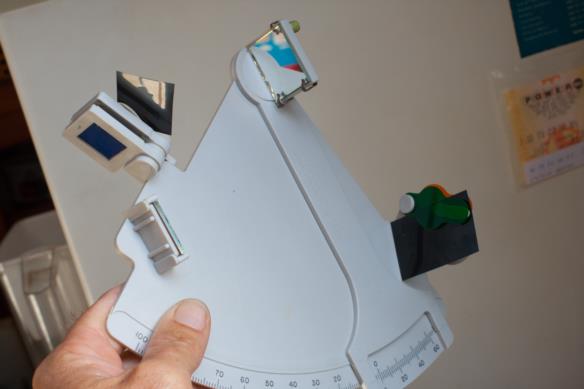
NavList:
A Community Devoted to the Preservation and Practice of Celestial Navigation and Other Methods of Traditional Wayfinding
From: Greg Rudzinski
Date: 2016 Mar 31, 13:22 -0700
An update on the Davis MK 3 arc error and index error calibration. The vernier on my example of a Davis MK 3 shows 4' off the arc (56' vernier mark aligned) when set zero to zero and then shows 4' on the arc when the 60' vernier mark is aligned. This makes for trouble :(( The best compromise has been to adjust the index mirror to the horizon for 2' on the arc at zero and 58' for the off arc alignment. For Sun observations the vernier scale between 20' and 40' is then used. Determining arc error has been frustrating. Intercepts through the arc range from a GPS position only gave a rough approximation of arc error. The better way has been to use measured horizontal angles using a metal sextant as the standard to compare to the Davis 3 with the difference being the arc error. Naturally index error is checked before and after each compared horizonal angle observation.
Davis MK 3 table to be tested through a complete set of Sun observations.
Altitude° Arc Corr.'
0 -0
5° -0
10° -0
15° -3'
20° -4'
25° -6'
30° to 90° -8'
Greg Rudzinski
From: Greg Rudzinski
Date: 2016 Mar 28, 12:51 -0700The Davis MK 3 plastic sextant can be improved by adding solar film filters for index mirror shading and sight tube shading (see image). Solar film shading the sight tube is of big help when determining index error by direct Sun observation vs. natural horizon. Solar film shading the index mirror will show a sharper Sun image than the stock shades.
Improve Davis MK 3 accuracy by recording arc error through the arc every 10°. Intercepts for observations made from a GPS position will serve as a good enough quick arc error to start with. For better arc error determination use a metal sextant as a standard to compare on simultaneous observations. An assisting fellow navigator is recommended. Otherwise a quick swap between sextants has to be done. Then there are lunar distances and star to star distances if time permits.
Greg Rudzinski
Attached File:







